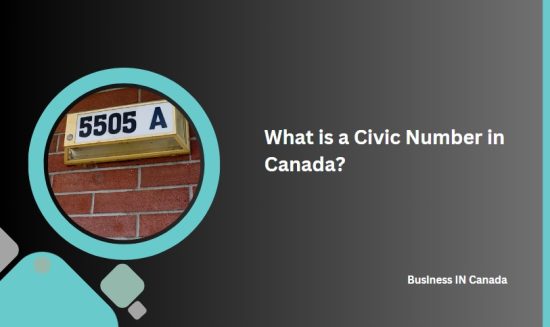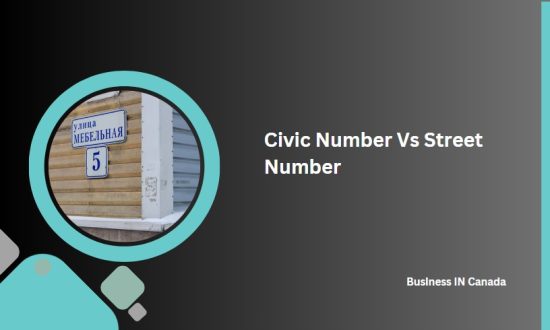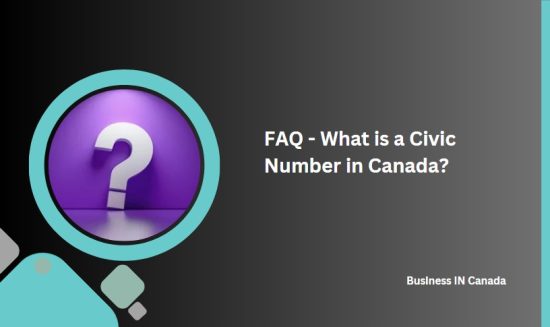Have you ever wondered what those numbers on your home or business mean? You know, the ones displayed prominently on your property seem to hold some mysterious significance. Well, wonder no more! We’re here to shed some light on the subject and answer the age-old question: What is a civic number in Canada?
Whether you’re a long-time resident or just moved in, this post will give you all the information you need about civic numbers, including their purpose, how to find yours and even how to get a new one if needed. So let’s dive right in and decode this important piece of Canadian address culture!
What is a Civic Number in Canada?

A civic number, also known as a street address or house number, is a combination of digits assigned to each property on a particular street in Canada. It identifies the location of your home or business and makes it easier for emergency services, postal workers and other service providers to find you.
Unlike the postal code, which identifies an area with specific boundaries, civic numbers are unique to each property. They usually consist of three parts: the street name, civic number and unit/apartment/suite, if applicable.
Civic numbers play an important role in identifying properties for various reasons such as taxation purposes, census data collection and land registration. In addition to that, they’re also used by GPS systems which help drivers locate their destination more quickly. It’s worth noting that there are some rules and regulations regarding civic numbering in Canada.
For example, new construction developments must follow certain guidelines when assigning addresses, while existing buildings may need to change their address if necessary. Understanding a civic number can prove useful for official purposes and everyday situations like giving directions or ordering online deliveries.
What is the Civic Number Used for?
Civic numbers are allocated to buildings, houses, and properties across Canada. These unique identifiers are used for a wide range of purposes, including emergency services response and postal deliveries. One of the primary uses of civic numbers is by emergency responders such as police officers, firefighters or paramedics. In case of an emergency situation in your area, they locate your property using its assigned civic number.
In addition to that, the civic number also helps with mail and package delivery. Having a clearly visible address label on your mailbox or at the front entrance can ensure prompt delivery.
Moreover, government agencies rely on these numeric addresses for tax assessment purposes; utility companies use them to identify where their customers live; real estate agents use them when listing homes for sale; banks utilize them when determining whether or not to grant mortgages on specific properties.
Civic numbers are essential in identifying locations throughout Canada – from residential homes to commercial buildings – making it easier for people to find places they need while ensuring efficient communication between government agencies and service providers.
Civic Number Vs Street Number

When it comes to addressing a property in Canada, there are two important numbers to consider: the civic number and the street number. While they may seem interchangeable or even identical at first glance, these two numbers serve different purposes.
The civic number is assigned by the local municipality or government and is used to identify a specific property within its jurisdiction. It is unique to each building or unit within a multi-unit complex and provides an exact location for emergency services, deliveries, and mail.
On the other hand, the street number refers to the position of a property along a particular street or road. This means that multiple properties can have the same street number but must be distinguished by their individual civic numbers.
Homeowners and renters alike must understand both their civic and street numbers when providing their addresses for various purposes, such as applying for credit cards or insurance policies. Inaccurate information could lead to delays in the delivery of important documents or even emergency services during times of crisis.
While similar in nature, it’s essential not to confuse your civic number with your street number. Understanding these differences will help ensure accurate delivery of mail and packages and proper identification during emergencies.
How to Find Your Civic Number?
To find out your civic number in Canada, you can start by looking at the entrance of your property. The civic address number is usually placed on a sign or plaque near the front door or driveway. It may also be painted on the curb or sidewalk in some areas.
If you are unable to locate your civic number this way, you can try contacting your local municipal office or city hall for assistance. They should have records of all registered addresses within their jurisdiction and will be able to provide you with your correct civic number.
If you have recently moved into a new home and do not know your civic address, contact the postal service to obtain a temporary address until one has been assigned to you. This will ensure that any mail sent to your new home gets delivered without delay.
It’s important to note that if changes are made to the structure of your property (such as adding an extension), it may affect your civic number. Therefore, it’s always best practice to check with city officials before making any major alterations so that they can update their records accordingly.
Civic Number Rules and Regulations

When it comes to civic numbers, there are certain rules and regulations that need to be followed. These guidelines ensure that every property has a unique identifier, making it easier for emergency services, mail delivery, and other essential services. In Canada, the civic number must be clearly visible from the street on the front of your property. It should have contrasting colours and be at least 3 inches in height. Failure to display your address can result in fines or even legal action.
Another important rule is that you must notify your local municipality immediately if you change the address or layout. This includes adding structures like garages or sheds and changing your driveway’s entrance location.
It’s also worth noting that each province may have its own specific regulations when it comes to civic numbering systems. For example, some places require odd numbers on one side of the street and even numbers on the other side. Following these rules ensures that everyone can easily identify properties by their unique civic number while maintaining consistency across all regions in Canada.
How Do I Get a New Civic Address?
If you’re moving to a new location that doesn’t have a civic address, or if your current address needs to be changed for some reason, you’ll need to go through the process of getting a new civic address. The first step is to contact your local municipality’s planning department and inquire about their specific requirements and procedures. They will inform you about any fees or paperwork that may be necessary.
You may also need to obtain permission from nearby property owners before the municipality can assign you a new civic number. This ensures there are no duplicates within close proximity of each other. Once all the requirements are met, the city planner will determine an appropriate number for your property based on its location in relation to neighbouring addresses on the road.
It’s important to remember that changing your address affects many aspects of daily life – including banking information, credit card statements, utility bills and more – so plan accordingly and give yourself enough time before making any major moves.
Obtaining a new civic address is not always an easy task. Still, it is necessary in order for emergency services such as police and ambulance units would easily locate your place when needed.
Is a Civic Number a Postal Code?

One common misconception about civic numbers is that they are the same as postal codes. However, this is not true. While both play a role in identifying a specific location within Canada, they serve different purposes. A civic number is used to identify a specific property or building on a particular street. It provides crucial information, such as the exact location of a residence or business establishment within its surrounding area.
On the other hand, postal codes refer to larger geographical areas composed of multiple streets and buildings. They are essential for mail delivery and help ensure that letters and packages reach their intended recipients promptly.
While it’s true that your address can determine your postal code, it doesn’t work the other way around – you cannot determine someone’s address using just their postal code.
While there may be some overlap between civic numbers and postal codes in terms of providing location information in Canada, they serve distinct functions. Understanding these differences can help avoid confusion when dealing with addresses and mail delivery services in the country.
Conclusion
When it comes to understanding what a civic number is in Canada, there are many important factors to consider. From the purpose of a civic number to how one can find their own, there are plenty of details to keep in mind.
Perhaps the most important thing to remember about civic numbers is that they serve as an essential identifier for homes and businesses across the country. Whether you’re trying to receive mail or need directions, your civic number plays a crucial role in helping others locate you.
While some people may confuse civic numbers with street numbers, it’s important to understand that these two forms of identification are not interchangeable. Civic numbers represent unique addresses within a city or town, while street numbers refer specifically to building locations on individual streets.
Understanding what a civic number is and its importance is crucial for anyone living in Canada. So whether you’re looking for your own address or want more information about this key form of identification, learning everything possible will undoubtedly prove invaluable over time.
FAQ – What is a Civic Number in Canada?

What is a civic number example?
A civic number, also known as a street address or a municipal address, is a unique numerical identifier assigned to residential, commercial and industrial properties in Canada. This number is used by emergency services, postal workers and other delivery personnel to locate specific addresses.
An example of a civic number would be “123 Main Street.” If applicable, the first three digits represent the house or building number, while the last two digits represent the unit or apartment numbers. In some cases, additional letters may be added after the numbers, such as “123A Main Street,” which indicates that it’s a separate dwelling on the same property.
It’s important to note that civic numbers are not interchangeable with postal codes. Postal codes are six-character alphanumeric codes assigned to every address in Canada for mail sorting purposes.
In Ontario specifically, non-civic addresses refer to rural route box addresses where post office boxes are used instead of street addresses. These types of addresses have their own set of rules and regulations for assigning new addresses. Understanding what a civic number is and its importance can help ensure the accurate delivery of goods and services while keeping communities safe.
What is a non civic address in Ontario?
In Ontario, a non-civic address is an address that does not have a building or structure on the property. These types of addresses are commonly given to vacant lots and undeveloped areas. Non-civic addresses also apply to properties that have been subdivided but have no buildings constructed on them.
Non-civic addresses are assigned by the municipality’s planning department, which uses specific criteria to determine how they will be designated. The process involves assigning a unique identifier code or number for each non-civic address.
It’s important to note that while these types of addresses don’t refer to physical structures, they still play an essential role in land use management and development processes in Ontario. They allow for proper record-keeping and identification of various parcels of land within municipalities.
Understanding the difference between civic and non-civic addresses can help individuals navigate property ownership laws and regulations more effectively in Ontario.
What are the four types of civic?
When it comes to understanding civic numbers in Canada, it’s important to know that there are actually four different types. The first type is the primary civic number, which is assigned to each property along a street or road and identifies its location within a municipality.
The second type is the secondary civic number, which is used when multiple buildings share the same primary address but have different entrances or units. For example, an apartment building may have one primary address but several secondary addresses for each individual unit.
The third type of civic number is called a subaddress or suite/unit number and represents specific areas within a building, such as offices or suites. This helps ensure mail and packages are delivered accurately even when multiple tenants occupy one physical location.
There are rural route addresses which lack traditional street names and house numbers altogether. These properties rely on numbered routes instead of physical addresses for identification purposes. Understanding these four types of civic numbers can help you easily navigate Canadian municipalities and ensure your mail ends up where it’s supposed to be delivered!
What is a civic responsibility?
Understanding what a civic number is and its importance in Canada is crucial for anyone who wants to navigate the country’s streets and neighbourhoods. It helps emergency responders, postal workers, delivery drivers, friends, and family easily find your location.
Remember that your civic number is not the same as your street name or address. It’s a unique identifier assigned by local authorities based on specific rules and regulations that must be followed.
As citizens of Canada, we all have certain responsibilities towards our community. Being aware of our surroundings, helping others when needed, and respecting laws and regulations are some examples of civic responsibilities we should uphold. Knowing what a civic number is in Canada can make daily life easier while fulfilling our roles as responsible Canadian citizens in society.










